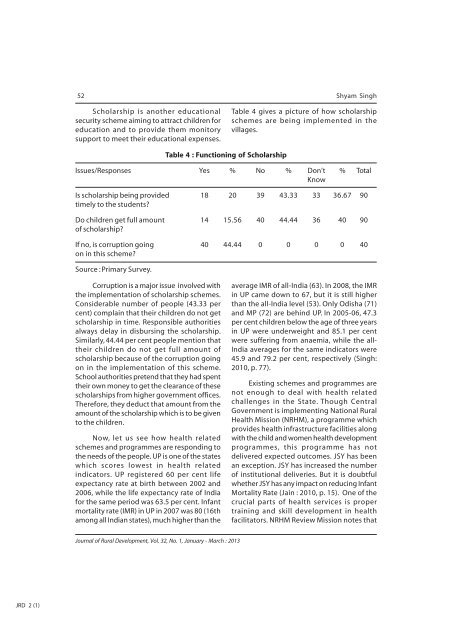January - March 2013 - National Institute of Rural Development
January - March 2013 - National Institute of Rural Development
January - March 2013 - National Institute of Rural Development
- No tags were found...
Create successful ePaper yourself
Turn your PDF publications into a flip-book with our unique Google optimized e-Paper software.
52 Shyam SinghScholarship is another educationalsecurity scheme aiming to attract children foreducation and to provide them monitorysupport to meet their educational expenses.Table 4 gives a picture <strong>of</strong> how scholarshipschemes are being implemented in thevillages.Table 4 : Functioning <strong>of</strong> ScholarshipIssues/Responses Yes % No % Don’t % TotalKnowIs scholarship being provided 18 20 39 43.33 33 36.67 90timely to the students?Do children get full amount 14 15.56 40 44.44 36 40 90<strong>of</strong> scholarship?If no, is corruption going 40 44.44 0 0 0 0 40on in this scheme?Source : Primary Survey.Corruption is a major issue involved withthe implementation <strong>of</strong> scholarship schemes.Considerable number <strong>of</strong> people (43.33 percent) complain that their children do not getscholarship in time. Responsible authoritiesalways delay in disbursing the scholarship.Similarly, 44.44 per cent people mention thattheir children do not get full amount <strong>of</strong>scholarship because <strong>of</strong> the corruption goingon in the implementation <strong>of</strong> this scheme.School authorities pretend that they had spenttheir own money to get the clearance <strong>of</strong> thesescholarships from higher government <strong>of</strong>fices.Therefore, they deduct that amount from theamount <strong>of</strong> the scholarship which is to be givento the children.Now, let us see how health relatedschemes and programmes are responding tothe needs <strong>of</strong> the people. UP is one <strong>of</strong> the stateswhich scores lowest in health relatedindicators. UP registered 60 per cent lifeexpectancy rate at birth between 2002 and2006, while the life expectancy rate <strong>of</strong> Indiafor the same period was 63.5 per cent. Infantmortality rate (IMR) in UP in 2007 was 80 (16thamong all Indian states), much higher than theaverage IMR <strong>of</strong> all-India (63). In 2008, the IMRin UP came down to 67, but it is still higherthan the all-India level (53). Only Odisha (71)and MP (72) are behind UP. In 2005-06, 47.3per cent children below the age <strong>of</strong> three yearsin UP were underweight and 85.1 per centwere suffering from anaemia, while the all-India averages for the same indicators were45.9 and 79.2 per cent, respectively (Singh:2010, p. 77).Existing schemes and programmes arenot enough to deal with health relatedchallenges in the State. Though CentralGovernment is implementing <strong>National</strong> <strong>Rural</strong>Health Mission (NRHM), a programme whichprovides health infrastructure facilities alongwith the child and women health developmentprogrammes, this programme has notdelivered expected outcomes. JSY has beenan exception. JSY has increased the number<strong>of</strong> institutional deliveries. But it is doubtfulwhether JSY has any impact on reducing InfantMortality Rate (Jain : 2010, p. 15). One <strong>of</strong> thecrucial parts <strong>of</strong> health services is propertraining and skill development in healthfacilitators. NRHM Review Mission notes thatJournal <strong>of</strong> <strong>Rural</strong> <strong>Development</strong>, Vol. 32, No. 1, <strong>January</strong> - <strong>March</strong> : <strong>2013</strong>JRD 2 (1)
















